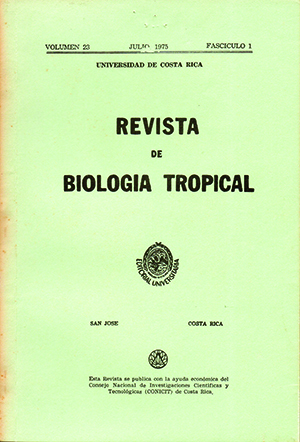Resumen
Observations in a semi-deciduous tropical wet forest in Guanacaste, Costa Rica, early in the dry season (December 1973 ) revealed that adults of the butterfly Morpho peleides (Lepidoptera: Nymphalidae: Morphinae) feed on tiny sap flows on exposed roots of the tree Samanea saman (Leguminoseae). These observations supplement earlier studies on the association of the butterflies with fallen, decaying fruits of the tree Guazuma ulmifolia (Sterculiaceae) in the same forest but during the previous dry season (January 1973). Morphoes collect in small groups of both sexes on the tree sap flows along with several species of ants. These feeding clubs, which are formed daily, usually in the afternoons, are tightly structured in that adults feed very closely together with no indications of agonistic behavior or courtship. When suddenly disturbed, the butterflies cease feeding and fly around the area before settling on nearby vegetation. The feeding behavior is different when morphoes feed on juices of Guazuma fruits: adults are widely dispersed and no feeding clubs are formed. Guazuma trees are more abundant in this forest and scattered over a larger area than the few Samanea trees. The association of Pierella luna; with the tree sap flows and the conspicuous lack of Caligo memmon, both abundant butterflies, is discussed from the standpoint of phylogenetic relationship between the Satyrinae and Morphinae. The implications of the changeover in feeding behavior of Morpho are discussed in terms of seasonality and destruction of forests by agricultural practices. Experiments employing baits predict changes in the dispersion of the adult population at different times during the dry season.
Citas
JANZEN, D. H. 1967. Synchronization of sexual reproduction of trees within the dry season in Central America. Evolution, 21: 620-637.
JANZEN, D. H., & T. W. SCHOENER 1968. Differences in insect abundance and diversity between wetter and drier sites during a tropical dry season. Ecology, 49: 96-110.
LEWONTlN, R. C. 1965. Selection in and of populations, p. 298-311. In J. A. Muore, (ed). ldeas in Modem Biology. Natural History Press, New York.
MAYR, E. 1970. Populations, species, and evolution. Belknap Press of Harvard University, Cambridge, Mass. 453 pp.
ORIANS, G. H. 1969. The number of bird species in some tropical forests. Ecology, 50: 783-801.
OWEN, D. F. 1971. Adaptation to man-made environments and phenology in Precis butterflies. Rev. Zool. Bot. Africaines, 83: 361-373.
SElTZ, A 1924. Macrolepidoptera of the world. vol. V. The American Rhopalocera. A. Kernan Verlag, Stuttgart. 1039 pp.
SLOBODKIN, L. B. 1967. Toward a predictive theory of evolution, p. 187-205. In R. C. Lewontin, (ed.). Papulati on Biology and Evolution. Syracuse Univ. Press, Syracuse, New York.
VANE-WRlGHT, R. I. 1972. Pre·courtship activity and a new scent organ in butterflies. Nature, 239: 338-340.
YOUNG, A. M. 1973. Studies on comparative ecology and ethology in adult populations of several species of Morpho butterflies (Lepidoptera: Morphidae). Slud. Neutrop. Fauna, 8: 17-50.
YOUNG, A. M. 1974. The rearing of Morpho peleides on peanuts. J. Lep. Soc., 28: 90-99.
YOUNG, A. M., & A. MUYSHONDT 1973. Notes on the biology of Morpho peleides in Central America. Caríb. J. Sci., 13: 1-49.
YOUNG, A. M., & ]. H. THOMASON 1974. The demography of a confined population of the butterfly Morpbo peleides during a tropical dry season. Stud. Neotrop. Fauna 9: 1-34.
WILSON, E. O. 1971. The isect societies. Belknap Press of Harvard Univ., Cambridge, Mass. 548 pp.
##plugins.facebook.comentarios##

Esta obra está bajo una licencia internacional Creative Commons Atribución 4.0.
Derechos de autor 1975 Revista de Biología Tropical


